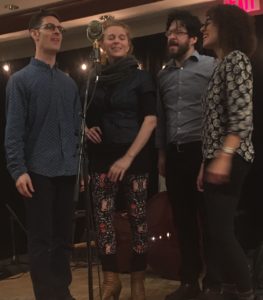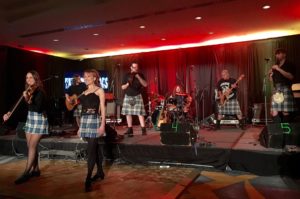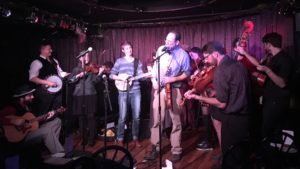Folk and Roots Music Artists Showcase Their Talents During APAP Conference in NYC
by Michael Kornfeld on Jan 19, 2018 • 3:38 pm No CommentsNearly 3,500 arts professionals from throughout the U.S. and nearly 30 other countries converged on New York City, Jan. 12-16, 2018 for the annual conference of the Association of Performing Arts Professionals (APAP). As in years past, dozens of performers from the folk, roots and singer-songwriter communities in the U.S., Canada, and several other countries were featured among the more than 1,000 showcases during the global multidisciplinary performing arts marketplace and conference. A number of booking agencies whose rosters include such artists were among the more than 350 exhibitors in the large EXPO Hall. The conference also featured networking opportunities galore, daily plenary sessions and keynote speakers, an awards ceremony, a town hall on the artist as activist, and a wide array of professional development workshops and forums.
The theme for 2018 was trans.ACT and focused on the transformative power of the arts. The conference’s plenary sessions explored the role and responsibility of the performing arts in our world today and the impact of trans-disciplinary thinking and partnerships that are breaking new ground in both the arts and the world beyond.
Showcases of Note Took Place at the Host Hotel and at Venues Around New York City
Showcases took place both at the New York Hilton Midtown, the conference hotel, and at venues throughout Manhattan. A few also were set in other New York City boroughs and beyond.
January 12:

Jayme Stone’s Folklife performs during the Global Routes Showcase at the APAP Conference (iPhone Photo: Michael Kornfeld)
January 13:

Tartan Terrors showcase their talents at the New York Hilton (iPhone Photo: Michael Kornfeld)
During the evening, I enjoyed extended sets of music by Jim Messina (of Loggins & Messina, Poco and Buffalo Springfield fame) and Grammy Award-winning southwest Louisiana-based Cajun band Beausoleil avec Michel Doucet at Iridium, a Manhattan nightclub that primarily features jazz artists. Back at the hotel late that night, I also enjoyed a short showcase by the vocal group Estonian Voices.
January 14:

Isle of Klezbos performs during a Klezmer brunch at City Winery (iPhone Photo: Michael Kornfeld)
January 15:

Texas-based artist Sam Baker was among the talented performers at The Sheen Center’s Loreto Theater (iPhone Photo: Michael Kornfeld)
Other folk and roots artists who showcased their talents during the APAP Conference included The Abrams Brothers, vocals and harp duo Addi & Jacq, multi-instrumentalists Andes Manta, contemporary folk trio A Band Called Honalee, Russian folk ensemble Barnya, young Irish tenor Emmet Cahill (who is also a member of Celtic Thunder), Colombian-Panamanian roots duo Calle Sur, The Everly Set (Sean Altman and Jack Skuller), guitarist Vicki Genfan, seven-sibling act The Hunts, Georgian polyphonic choir Iberi, Quebec’s Melisande [Electrotrad], Guy Mendilow Ensemble, Mojo & the Bayou Gypsies, accordionist and composer-singer Sam Reider, eclectic roots ensemble Upstate Rubdown, Ottawa Valley fiddler April Verch and her band, and Yemen Blues. Randy Noojin presented 15-minute excerpts from Hard Travelin’ with Woody, his one-man multimedia show featuring the music and artwork of Woody Guthrie, as well as Seeger — A multimedia solo show featuring the music of Pete Seeger. Sage Artists shared excerpts of Call Mr. Robeson: A Life, With Songs.” Cast members from Lonesome Traveler: The Concert also performed short musical excerpts from the show, along with narration that helps tell the story of American folk and folk-rock music from Woody Guthrie to Bob Dylan and beyond. Artists in various other musical genres also showcased their talents, while comedy, dance and theatrical showcases also were part of the mx.
Artists who Hosted Showcases Offer Their Reflections
Jayme Stone notes that he started curating a showcase at last year’s APAP Conference “to create a space for independent roots/world music artists to have their music heard by performing arts center directors and festival programmers. My goal was to make the cost slightly more affordable for artists and to create an opportunity for underrepresented artists to have a seat at the table. Most of the artists at our showcase do not have agents, which is rare at this conference.”
“Attending the conference has proven to have a profound impact on my touring career,” says Clay Ross, who fronts both Matuto and Ranky Tanky and produced the Global Routes Music Showcase with Stone. Noting that he’s been attending APAP conferences for the past seven years, Ross told AcousticMusicScene.com: “It’s given me the opportunity to connect with presenters, agents, managers, and other industry professionals around the world.” Those connections have helped prompt bookings for his bands at a number of prestigious Americana, roots and jazz venues and festivals.
“As an artist, I think it’s really important to understand the various perspectives, challenges and concerns associated with all sides of the business,” Ross continued. “By hanging around at conferences like APAP and forging relationships across the field, you start to see more clearly how your talents and interests might best align with potential partners. You start to understand that you don’t need to be everything to everyone, but can instead find your own comfortable niche. “

Fiddling poet Ken Waldman’s roots music variety show at Don’t Tell Mama was an APAP Conference highlight (iPhone Photo: Michael Kornfeld)
Waldman continues, “Going to APAP, we’re more apt to find jobs that pay $2,500, $5,000 and up.” While acknowledging that nothing is guaranteed, he believes that “by offering this particular roots music showcase evening, I’m nudging the odds in my favor. It’s an investment I’ve been happy to make.”
“Because I attend so many [conferences], I don’t feel stressed thinking it’s now or never. I see people I’ve met in prior years [and those] I’ve never met before. If some jobs come my way, great — but it doesn’t have to be the result of a particular conference or showcase. It’s invariably the result of attending as many of these conferences as I can.” He maintains that presenters who attend APAP conferences tend to have more experience in the field, access to bigger budgets, and are just so inundated with pitches from artists and their agents that they are virtually impossible to reach by email or phone. “But at a conference there’s the chance to actually meet someone which means if I do have reason to send an email or make a phone call, there’s a much greater chance of having the email returned or the call taken.”
WAVELENGTHS World Music Pre-Conference Features An Inspirational Keynote
Among several arts-related forums that preceded the conference was a two-day WAVELENGTHS World Music Pre-Conference featuring a keynote, panel discussions, workshops, and an artist pitch session co-produced by music PR firm Rock Paper Scissors in cooperation with GlobalFEST.
Keynoting WAVELENGTHS was Emel Mathlouthi, a Tunisian singer-songwriter whose songs played a major role in Arab Spring and led to her being called “the voice of the Tunisian revolution.” She offered heartfelt comments and inspiring thoughts as she spoke of the role of the artist in turbulent times and the importance of empathy.
Here’s a link to a video of Emel performing her song “ Kelmti Horra “(“My Word is Free”) during the 2015 Nobel Peace Prize Concert:
https://www.youtube.com/watch?v=wJ79iEfus8E
“For me, art has always been very powerful in connecting us…[and] in opening doors, [and in transcending] barriers and limits,” she said. “We’re all coming from the same place, and we all have a heart … Art is an international language. I really wanted to convey that,” she continued, noting her collaborations with musicians from other parts of the world. Until recently, Emel, who cites Joan Baez among her influences, has primarily written and sung music in Arabic, and some of her songs contain messages that transcend politics.

Emil Mathlouthi, “the voice of the Tunisian revolution,” keynoted the WAVELENGTHS World Music Pre-Conference (Photo: Alex & Iggy)
She advocates for the elimination of ethnic and political silos that have been used to pigeonhole and minimize artists’ cross-cultural appeal and expressing her personal desire to appeal to people based on her humanity, rather than feel like just an ethnic or political artist. “We’re reaching times where all the concepts have to change and allow all the artists who are coming from the world music sphere to be able to explore themselves and go beyond any preconceived notions,” she declared. While acknowledging that she has a conscience and a point of view, and expressing pride in the social impact that her music has had in helping to energize the movement for change in the Arab world, she concluded: “At the end of the day, I’m an artist, a musician, a singer.”
—————————————————————————–
About the Association of Performing Arts Professionals (APAP)
 A Washington, DC-based nonprofit –- previously known as the Association of Performing Arts Presenters until changing its name last year — APAP is a national service, advocacy and membership organization dedicated to developing and supporting a robust performing arts presenting field and the professionals who work within it.
A Washington, DC-based nonprofit –- previously known as the Association of Performing Arts Presenters until changing its name last year — APAP is a national service, advocacy and membership organization dedicated to developing and supporting a robust performing arts presenting field and the professionals who work within it.
“As artists and arts makers, we must embrace our role to engage in the constant and dynamic societal transformation that we are a part of by acknowledging it, reflecting it, discussing it, and leading it,” says Mario Garcia Durham, APAP’s president and CEO. “Our strength as an industry lies in our ability to create, produce, present, share and stimulate audiences everywhere with works that both embrace and acknowledge our differences and increase our understanding of one another.”
The next APAP Conference in New York is set for January 4-8, 2019. More information on the organization may be found on its website: www.apap365.org.

Like/Follow Us!